Wringer

by Jerry Spinelli. ![]() Novel. 256 pages. Grades 5-8.
Novel. 256 pages. Grades 5-8.
Find this book: Amazon

Teacher's Guide
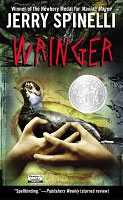
In this town the killing of the pigeons has become a yearly event in which the whole community participates. The men shoot them as they are released on the town green and the ten year old boys are wringers who run out and twist the necks of the birds that are only wounded. Palmer has just gained tentative acceptance by some of his peers including the neighborhood bully, Beans. With them he has harassed his one time only friend Dorothy whose handling of the matter is wonderful. Palmer is already dreading the day when he takes his place on the field as a wringer when a pigeon appears at his window and demands entrance. Palmer names the bird Nipper and hides his attachment to it from his friends. It's the much maligned Dorothy who helps him get Nipper out of town. Spinelli tells his grim tale with an understanding of the rites of childhood and with flashes of humor to lighten our load.
On one level, this book deals with peer pressure and its effects. On a surface level, it deals with pets, giving it yet another hook for middle school readers. Although the boy in this novel is just approaching his tenth birthday, the novel itself is probably best understood by kids from fifth grade up. The idea that the adults in the town are participating in a barbaric rite into which they bring young boys is at the crux of the novel and should lead students into discussions about other such rites in their worlds. Like all Spinelli novels, this one is accessible and should appeal to boys at least as much as to girls. There are large questions addressed here such as what to do when society (in this case one town) mandates behavior which we think is wrong and how to deal with bullies and peer pressure. It deals with violence as condoned by society and the choices we make in life. The dynamics of Palmer's peer group also make for good discussion. The need for face-saving, the need to torment someone perceived as weaker and the effect of passive resistance are also part of the action.
(Continued Below)
Advertisement:

Things to Talk About and Notice
- Is Palmer a hero in the sense of being a heroic character? What makes a hero anyway? Who do you know or know of that fits the label hero?
- Among many other pressures on Palmer is the bullying by Beans. How does Palmer handle it? What are other ways that you have read about, thought about or done that would help in dealing with bullies?
- What price does Palmer pay for his actions?
- The pigeon shows up at the bedroom window of the one boy in town who is thinking of rebelling against the custom of wringing the necks of pigeons. How likely is that? It's an almost magical event. Why do you think Spinelli uses it?
- Although there are moments that tear your heart out in this book and other moments which are almost unbearably brutal, there are also some very funny scenes. Find and read one aloud.

Activities
- Palmer has been thinking about the day when he must wring the pigeons' necks for years. Find evidence of this in the novel.
- Make a list of the alternatives Palmer has regarding the pigeon shoot. Then, prioritize the alternatives in terms of feasibility and results. What would you do?
- Palmer is pressured by many people in this book. Make a list of those people and the behavior they expect from Palmer. Which of those have the greatest effect on what Palmer eventually does?
- On the jacket flap, the book has a subtitle "Not All Birthdays are Welcome." In effect, Palmer is terrified of growing up. Make two lists of your own feelings about becoming an adult: good and bad.
- On paper, place the name of each child in the book in a separate circle. Draw lines to other characters on the page to which that character has some connection in the story. Along the line write the events that brought the two characters together. Color the strongest characters differently than the others. Compare your papers to those of others in the class.
- What's the difference between what the people in Palmer's town do and any organized hunt? Find out about the buffalo hunt on the Yellowstone boundary each year. Is that different?
- Although the shooting ceremony described in this book is probably unique, there are many places where birds have become pests in a community and various steps have been taken to control them. Find out about those situations and their resulting effects.
- Find out about pigeons. Where do they come from? Why do they hang around urban areas? Where do they fit in the food chain? Who are their enemies?
(Continued Below)
Advertisement:

Related Books
 Rome Antics by David Macaulay. (1997, Houghton. ISBN 9780395822791. Order Info.) Picture Book. 80 pages. Gr 2-9.
Rome Antics by David Macaulay. (1997, Houghton. ISBN 9780395822791. Order Info.) Picture Book. 80 pages. Gr 2-9.
Macaulay gives us a chance to play in and among the monuments and ancient buildings of Rome in this delightful book which shows his love and knowledge of the city. Before the title page, a woman releases a homing pigeon and we follow that pigeon's flight as a red line through the city getting a pigeon's eye view of the juxtaposition of things mundane and glorious.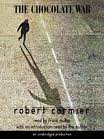 The Chocolate War by Robert Cormier. (1974, Knopf. ISBN 9780375829871. Order Info.) Novel. 272 pages. Gr 5-9.
The Chocolate War by Robert Cormier. (1974, Knopf. ISBN 9780375829871. Order Info.) Novel. 272 pages. Gr 5-9.
It's not a whole town here but a private school where violence is condoned and encouraged. Sinister Brother Leon, the assistant headmaster of the school, conducts a fund-raising activity and, to insure its success, he enlists the help of the school's secret society, The Vigils. The head of the Vigils, Archie, is equally ruthless and the coming together of these two nearly results in the death of Jerry, a newcomer who refuses to sell the chocolates. For some in the school, Jerry is a hero for others he is a target for their pent-up hatred. Sees Behind Trees by Michael Dorris. (1996, Hyperion. ISBN 9780786813575. Order Info.) Novel. 128 pages. Gr 4-6.
Sees Behind Trees by Michael Dorris. (1996, Hyperion. ISBN 9780786813575. Order Info.) Novel. 128 pages. Gr 4-6.
Walnut has limited vision and his mother, whose job it is to prepare him for the rites of manhood, teaches him to use his other senses to see what others cannot. He earns the name Sees Behind Trees and one of the elders, Gray Fire, asks Sees Behind Trees to accompany him on a quest. This short book is remarkably well done.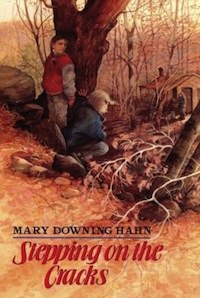
 Grades 4 - 7
Grades 4 - 7
Stepping on the Cracks by Mary Downing Hahn. Novel. 224 pages.
Find this book: Local Bookstore, Amazon, B&N
In 1944, while her brother is overseas fighting in World War II, eleven-year-old Margaret gets a new view on the school bully Gordy, when she finds him hiding his brother Stuart, an army deserter, and decides to help him. When Margaret's own brother is killed in the war, her feelings toward Stuart become more complicated. Read More in our Featured Book Teachers Guide with discussion questions, extension activities, related books and links.- The Night the Bells Rang by Natalie Kinsey-Warnock. (1991, Cobblehill. ISBN 0525650741. Order Info.) Novel. 132 pages. Gr 4-7.
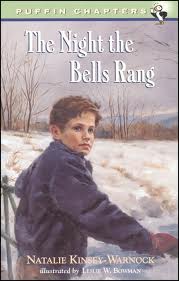
Here's another story that concerns a bully. This is a gentle story of life in northern Vermont during the first World War. Mason lives on a farm with his younger brother and parents and much of the book describes such rural pastimes, but the heart of the book lies in the perceptions Mason has toward Aden Cutler, a school bully. When every bell in town rings out for the end of the war, it is Mason who approaches Aden's mother who stands alone grieving for her son, killed in battle, knowing that no one in the celebrating town thought kindly of her son. 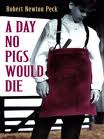 A Day No Pigs Would Die by Robert Newton Peck. (1994, Laural Leaf. ISBN 9780679853060. Order Info.) Novel. 176 pages. Gr 4-8.
A Day No Pigs Would Die by Robert Newton Peck. (1994, Laural Leaf. ISBN 9780679853060. Order Info.) Novel. 176 pages. Gr 4-8.
Like Palmer, in Wringer, our narrator must confront the death of a beloved pet. This brief novel is at times tender and other times harsh. It deals with the abrupt end of a childhood (supposedly the author's) when the realities of farm life mean that he must kill his pet pig. There is fine characterization here and the Yankee values of the thirties in Vermont come to the fore.
(Continued Below)
Advertisement:

Related Areas Within Carol Hurst's Children's Literature Web Site
- Parts of this article are from our book Using Literature in the Middle School Curriculum.
More information, including sample chapters. - All our Featured Book Articles
Teachers Guides with reviews, activities, related books, and links. Bullying through Kid's Books: Featured Subject
With books, activities and links.- Free Teacher's Guides: A listing of all our teacher's guides. Picture Books, Nonfiction and Fiction.

